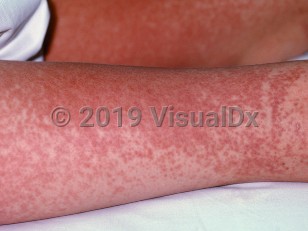Drug-induced hypersensitivity syndrome in Adult
Alerts and Notices
Important News & Links
Synopsis

Clinically, symptoms develop 2-8 weeks after initiation of the responsible drug. If a patient is rechallenged with the drug, the reaction will occur within 24 hours. An exanthematous eruption is present in over 80% of cases and can worsen even after the withdrawal of the offending drug. Eosinophilia and/or a mononucleosis-like atypical lymphocytosis is commonly observed. The liver is the most commonly and severely affected visceral site. Myocarditis, interstitial pneumonitis, interstitial nephritis, encephalitis, myositis, pancreatitis, and thyroiditis have all been observed. Cutaneous and visceral involvement may persist for several months after discontinuation of the offending drug.
Some patients may experience multiple episodes of remission and relapse. Some instances of relapse have been associated with reactivation of HHV-6, HHV-7, EBV, or CMV.
Hypothyroidism and other autoimmune conditions such as pancreatitis, myocarditis, or type 1 diabetes may develop several months after the acute phase of the illness. Systemic lupus erythematosus, bullous pemphigoid, arthritis, alopecia, vitiligo, and sclerodermoid graft-versus-host disease (GVHD) have also been reported.
The most commonly implicated drug groups causing DIHS include anticonvulsants, sulfonamides, and NSAIDs. Anticonvulsants include phenytoin, carbamazepine, phenobarbital, and lamotrigine. DIHS secondary to anticonvulsants is occasionally referred to as anticonvulsant hypersensitivity syndrome. Sulfonamide-induced DIHS can have an earlier onset than hypersensitivity syndromes caused by other classes of antibiotics, appearing as early as 7-14 days after initiation of therapy. Minocycline, allopurinol, azathioprine, metronidazole, dapsone, antiretroviral agents (eg, abacavir), clopidogrel, and ticlopidine are other known causes of DIHS.
It is imperative to withdraw the suspect medication(s) as soon as possible, as there is a 10% mortality associated with complications of organ inflammation, with liver injury being the most common cause of mortality and myocarditis the second most common.
Codes
D72.12 – Drug rash with eosinophilia and systemic symptoms syndrome
SNOMEDCT:
702809001 – Drug-induced hypersensitivity syndrome
Look For
Subscription Required
Diagnostic Pearls
Subscription Required
Differential Diagnosis & Pitfalls

Subscription Required
Best Tests
Subscription Required
Management Pearls
Subscription Required
Therapy
Subscription Required
Drug Reaction Data
Subscription Required
References
Subscription Required
Last Updated:04/05/2023

